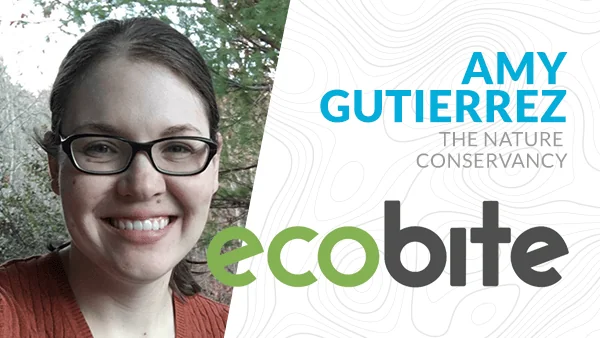As the Climate and Lands Coordinator at The Nature Conservancy (TNC), Amy Gutierrez focuses on climate and stewardship issues in the state of Georgia. She believes that a rapid transition to clean energy could lessen the effects of climate change and protect critical biodiversity. But what about when the transition itself poses a threat to biodiversity? It doesn’t have to—and that’s where the Low Impact Solar Siting Tool comes in. At TNC, says Gutierrez, “we’re looking for win-win scenarios.”
The Georgia Low Impact Solar Siting Tool, known as “Georgia LISST,” comes from the confluence of traditional land conservation and climate considerations. LISST originated from a collaboration between students and the NASA DEVELOP program, which gives students real-world challenges to solve using spatial data.
The Nature Conservancy became involved with the tool by way of the gopher tortoise, a state reptile of Georgia. The gopher tortoise is federally protected in a portion of its range, and has become a regular focus at TNC, as they manage land that encompasses the tortoise’s habitat. Beginning around 2017, Gutierrez estimates, TNC partners began alerting them of conflicts between larger utility-scale solar siting facilities and gopher tortoises, in which tortoise boroughs were being impacted by solar development, and the tortoises needed to be relocated as a result.
Georgia ranks in the top 10 states for the yearly rate of solar installations. “In the process of accelerating the transition to clean energy, we need to also preserve biodiversity,” says Gutierrez. TNC aims to balance these priorities: “We’re looking for win-win scenarios.” TNC began working to develop spatial tools and resources for developers and others in the space to improve the process of siting by making it easier to identify areas likely to present this conflict.
As LISST developed further, partnerships were formed with state and federal agencies, as well as experts from nonprofits, and finally utility companies to ensure that the tool suited their needs.
LISST takes a two-pronged approach to the challenge of solar siting: it considers environmental sensitivity, meaning the likely impacts of solar development, alongside solar suitability, which considers the physical land characteristics necessary for solar sites. The ideal solar site is one with low environmental sensitivity and high solar suitability.
LISST pulls data together and ranks areas into a color-coded system of “overall preference ranking” to source low-impact solar development areas, ensuring that sites are not in conflict with biodiversity. The ranking system provides an idea of the variation within the landscape, and helps decision-makers compare different locations and select ones with the least impact.
“One of our challenges…is that we do not have statewide environmental solar permitting here in Georgia,” says Gutierrez, “so many environmental considerations end up being dealt with either in agreements between a developer and the utility company, or in the local regulations, or in Stormwater and Erosion and Sediment Permitting. Our Natural Resources agencies don’t get pulled in unless there’s a concern.”
LISST aims to lend a proactive measure to the process by frontloading the identification of issues before a site is selected. This avoids the scenario of a solar developer investing multiple years and significant cash into a site only to find they’ll need to relocate a number of tortoises, or come up with a Habitat Conservation Plan. Ultimately, the LISST tool benefits both developers and the environment, by helping developers to meet their renewable energy goals, timelines, and budgets in an environmentally-friendly manner.
Solar development has accelerated since LISST was published originally in 2019, and then updated with new data in 2021. Compared to the beginning, says Gutierrez, the tool has gained a lot of traction and active partnerships. LISST has established a strong foothold and established a methodology for siting solar, and she sees progress beginning to occur in areas beyond Georgia: South Carolina Department of Natural Resources, for example, has a Solar Habitat Certification, and has adopted and refined LISST methodology into a different tool, which they recently published. Gutierrez is in a number of conversations with regional partners from Fish and Wildlife Service, Department of Defense, and other state agencies seeking to adopt a version of LISST tailored for their region.
The future of LISST and similar initiatives is bright as investment in solar increases across the country. Gutierrez and her colleagues are working with partners to establish best management practice guidance for Georgia. They’re also working with local governments and municipalities to brainstorm what kinds of ordinances they might want to write, what kind of approvals to provide, what permits would be necessary from a zoning perspective, and more. “We can provide them a tool that is publicly available and simplified, so that even if they don’t have in-house GIS expertise, they can still use and interpret and incorporate their findings into their planning processes,” she says.
In some areas of Georgia, local jurisdictions have placed moratoria on solar development due to conflicts such as local opposition, species impacts, land and farmland conversion, and other hot-button issues, until they can determine a schematic for a sustainable process. TNC hopes that a tool like LISST can prevent the barriers to clean energy transition caused by moratoria like these. The slower the transition, Gutierrez says, the greater the impacts to biodiversity. “We’re trying to make sure that we can go smart to go fast.”



